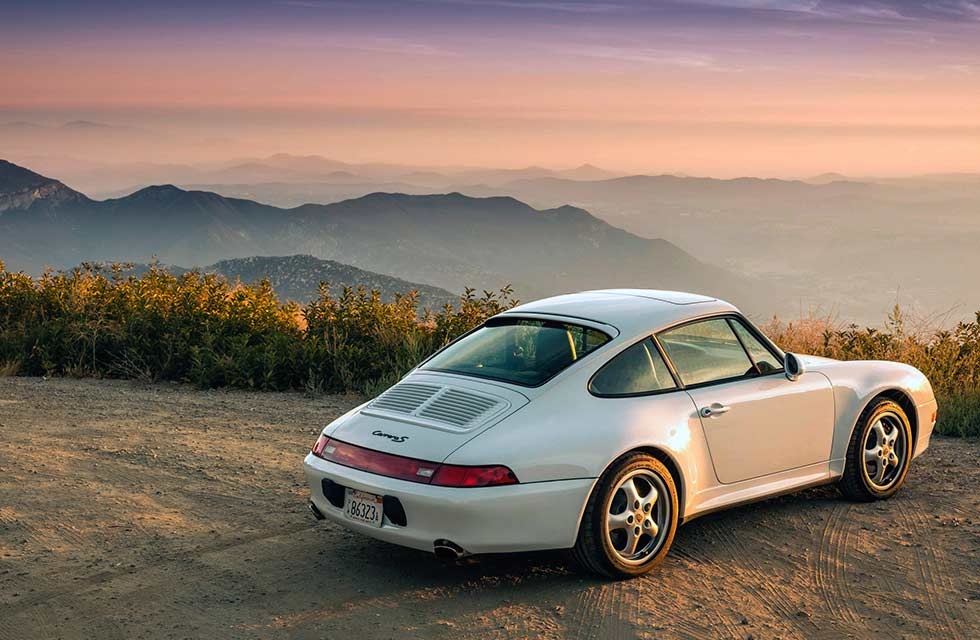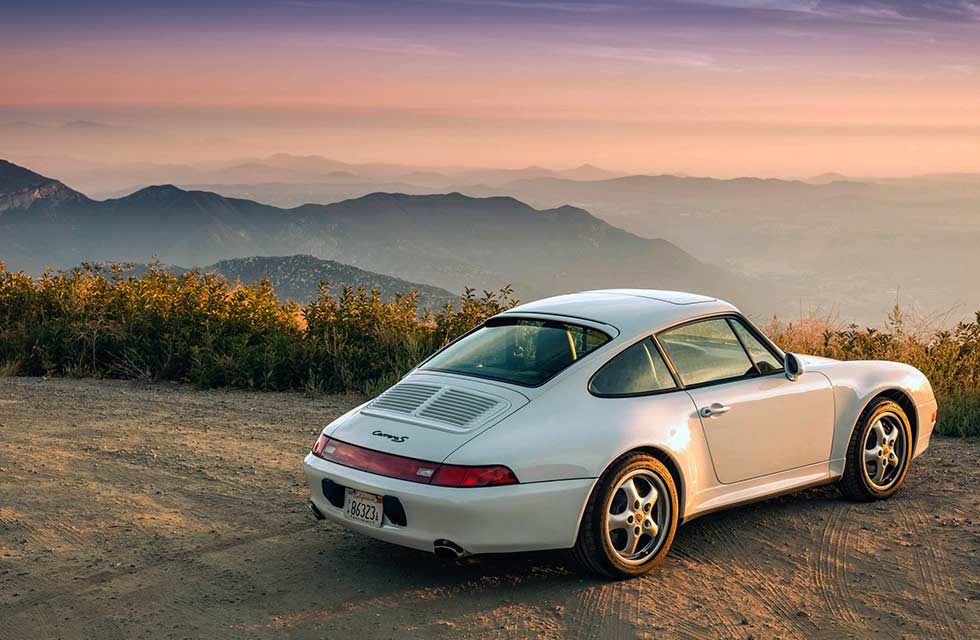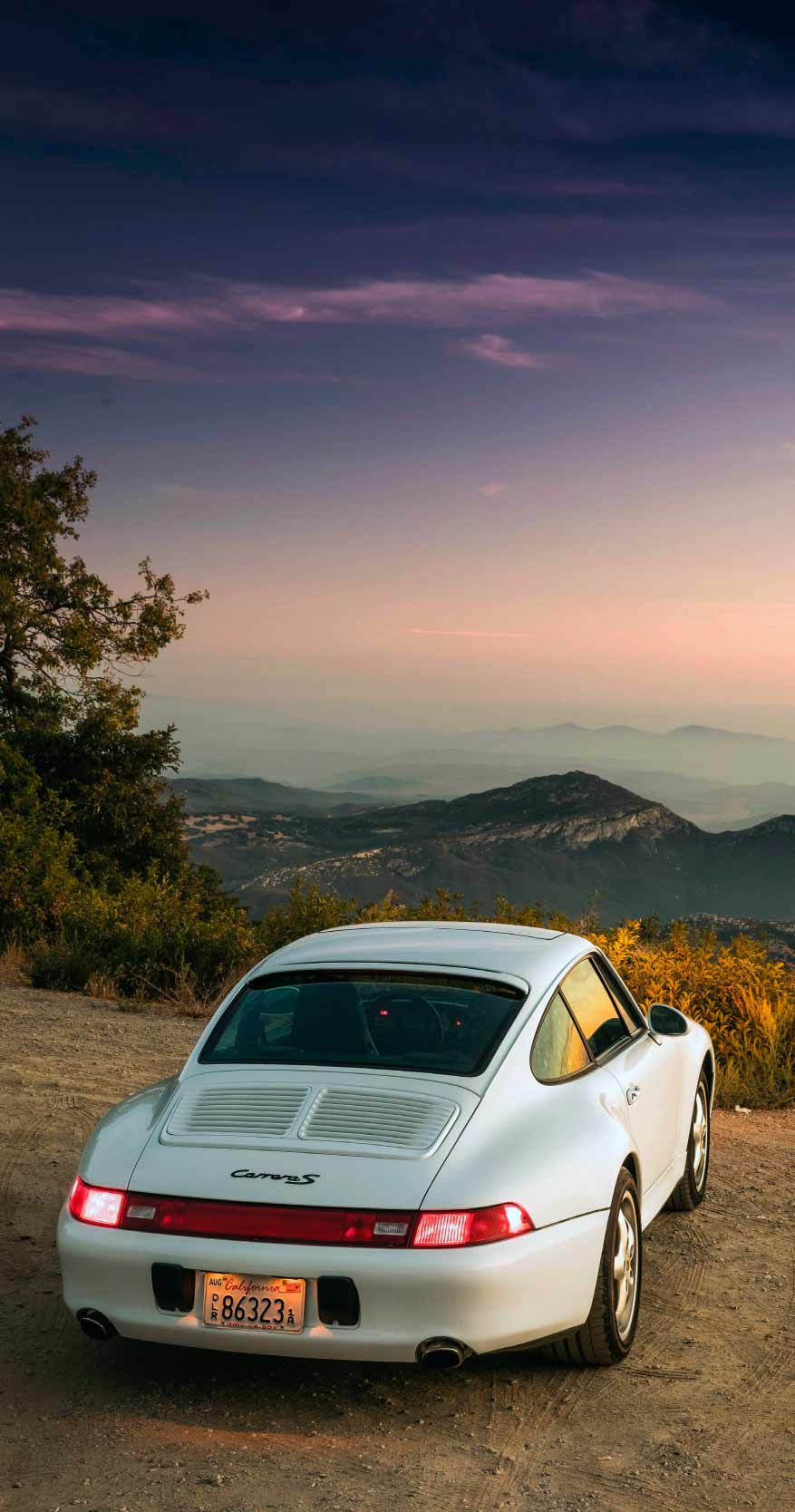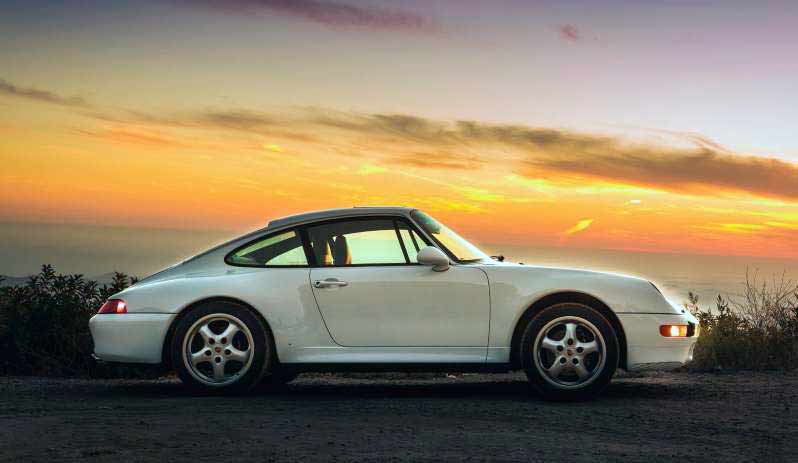
Could the Turbo-look 1997 Porsche 911 Carrera S 993 be one of the finest modern classics? Written by Joe Williams. Photography by Daniel Pullen.
WIDE-BODIED WONDER 993 CARRERA S Why it’s better than its big-spec C4S brother. Turbo widebody, naturally aspirated engine, rear-wheel drive. Is this the most desirable modern classic Carrera?
Porsche has a rich history of building decorated Turbo-look cars. It began, of course, with the Turbo itself: almost immediately from its release in 1975, customers desired those wide hips on a 911 of their own, even if they could never afford the monumental $26,750 for the real thing.

Independent coach builders saw an opportunity, offering to convert customers’ narrow-bodied Carreras and, later on, SCs, to 930-spec. Some offered to do so via fibreglass solutions, but steel arches, as per the factory Turbo specification, were the only real way to get the proper look with an authentic and consistent arch line. Porsche itself didn’t offer a genuine Turbo-look option until 1985 with the arrival of the 3.2 Carrera SSE (SuperSport Equipment). This mated the naturally aspirated 3,164cc flat six from the Carrera to the body and running gear of the 930 3.3, available in Coupe, Cabriolet and even Targa body styles. Option M491 greatly improved handling, even if its wider stance meant a sacrifice in top-end speed.
It was a fine blueprint, though. The popularity of the SSE’s aggressive stance was such that Porsche again replicated the look for the 964 generation with the 964 WTL and Turbo-look Cabriolet. The slight change was that Porsche had by now decided to apply the Carrera’s active rear wing to the Turbo widebody, allowing for a key deviation which visually protected the rear while also maintaining the cleaner lines of the atmospheric-engined Carreras.

When it came to signing of the subsequent 993 generation and, indeed, the era of air-cooled 911s by the late 1990s, Zuffenhausen knew exactly what would appeal. The 993 Carrera 4S arrived first for the 1997 model year, again offering the naturally aspirated flat six engine from the Carrera with the body and chassis of the Turbo, which was all-wheel drive for the first time. This meant the C4S was offered only with a manual gearbox.
On paper, it should have been a thrilling 911, the sure-footedness of the Turbo chassis matched with the purity of the Carrera’s engine. Customers certainly expected as much, with the wider-hipped 4S outselling its Carrera 4 sister two to one. However, for some, it’s a disappointing 911 to drive: previous tests in this magazine have highlighted the C4S’s portly 1,520kg weight which, without the punch of twin turbochargers, means the car’s performance is sluggish at best. A sheep in wolf ’s clothing, dynamically it’s left wanting too, that AWD system dulling the messages from the front wheels.

Porsche had an answer for that, arriving the following model year. The 993 Carrera S once again boasted the visual appeal of Tony Hatter’s design in Turbo-spec widebody form, mated to a VarioRam engine from the Carrera. However, from here the Carrera S deviated from the 4S, ditching its Turbospec suspension and ‘Big Red’ brakes as well as, quite obviously, its all-wheel-drive system. The 993 Carrera S was therefore a rear-driven, naturally aspirated 911 in a purposeful wide body, which has garnered a keen following among Porsche enthusiasts ever since.
It’s also a rare commodity: only 3,714 were made, which is roughly half of the Carrera 4S build number and just over 5 per cent of overall rear-driven 993 Carrera production. Its rarity and unique spec may be assured, but there’s one more critical question which needs to be answered: in driver’s terms, is it a marked improvement over the 4S?
Matt Kenyon has given us the opportunity to find out, which is why we find ourselves standing next to a Glacier white example, the 23,000 miles displayed on its odometer verified by the car’s pristine condition throughout. This 911 actually belongs to Matt’s father, but is currently up for sale – for the right price – through Makellos Classics.
Sitting pretty under its Turbo shell, it doesn’t look as awkward from the front as a standard 993 Carrera, whose overly soft looks are a valid criticism despite the overall popularity of the base 993 generation. The Carrera S’s Turbo front bumper with deeper spoiler sees to that, the car also leaving the factory some 20mm lower too. In fact, gazing at the whole car, it’s hard not to be smitten by the profile of the C2S. Its front end just looks more complete, lowing neatly to the rear of the car and the bulging contours of those rear hips. That subtle boost in brawn means the lines just work better, in my view. At the rear of the car you’ll find the Carrera S’s pièce de résistance in design. It’s a flatback with an active wing matching the profile of standard Carreras, though its configuration is unique, the decklid slats being split into two halves. Fixed Turbo spoilers were a popular option, albeit a superluous one… without those ‘Big Red’ brakes or Turbo suspension you were never likely to fool anyone.

Beneath all that you’ll usually find ‘Turbo Twist’ wheels rolling under those wider arches, though this example has optional 17-inch factory Cup 2 wheels plus a limited-slip differential included in its repertoire. It looks the part, but we want to find out how it drives, so we’d better get going.
Taking our spot behind the wheel is a real treat. The rich, black leather adorning the interior smells like new; the seats, having barely been worn in, still devoid of any sheen to their base or bolsters. The steering wheel ahead, which looks like it’s barely been touched in its 22 years, is of the normal four-spoke variety taken from the Carrera, it losing the bulkiness of the 964’s four-spoked, air-bagged effort, though I wouldn’t put it down as an award winner for aesthetics. Behind it the 911’s five-strong assortment of dials have been neatly dressed in aluminium bezels unique to the Carrera S, the shifter and handbrake lever below getting the same deft treatment.
Twisting the key in its ignition, the Glacier white 911 fires harmoniously to life, a mellow thrum emitted from the 993’s dual exhaust pipes. The 993’s more upright windscreen, thin A-pillars and narrow dashboard are an everlasting hallmark of the classic 911, yet its creep towards modernity is evident in how famously easy it is to drive. We get going with little incident, venturing out in search of SoCal’s finest blacktop in the last air-cooled, naturally aspirated 911.
Without the harshness of that Turbo suspension bequeathed on the C4S, the C2S’s ride is abundantly palatable, most surface impurities beneath us being dealt with little fuss. The long gearing associated with the 993 generation remains evident here, though its gear changes are gloriously polished compared to, say, a 964, exemplified by the lightness of the shifter and deftness of its movement. It’s near-on the perfect set-up: unmistakably direct and gloriously weightless without being superficially so, a shorter throw would, however, bring a welcome layer of intensity.
A longer stretch of road allows for a first test of the Carrera S’s accelerative capabilities, throwing up some interesting results. An added punch of torque before the mid-range is evident, this a result of the VarioRam system introduced for the 993 RS and fitted to all 993s from 1995 – look for the alloy plenum atop the flat six if you’re not sure. However, VarioRam Carreras – including the 2S and 4S – have only a 13hp increase overall over pre-1995 cars, and being some 80 kilograms heavier than the ordinary 993 Carrera, the 2S is simply not as quick in a straight line as its narrow-bodied stablemate. However, this wide-bodied 911 makes up for its deicit in outright pace in the corners, and it doesn’t take long to find some twisting tarmac to prove my point. Launching enthusiastically into the first sweeping left-hand turn, a little weighting up of the front end is needed to get the nose to dive, but after that the car is largely unlustered through the mid-corner. There’s still noticeable body roll, but whereas a narrow-bodied Carrera might have lustered, the wider track and superior grip afforded by the larger footprint of the 2S’s tyres means the car remains pretty much stable. In faster, more lowing corners such as these it is a superior car, ensuring a smoother affair when stitching a succession of snaking corners together like this. Pushing a little more into a tighter right-hander, the nose starts to give way first, but it happens at a much later stage than a 4S, for example, would have managed, and is controllable with just a little pedal moderation.
The steering, too, is sublime: brilliantly weighted and far richer with its feedback than the 4S, its clarity gives confidence, its speed only adding to the sensation of the 2S’s ability to pivot more seamlessly from its nose.
In fact, the Carrera S is abundantly more agile than the Carrera 4S full stop. Unlike the 4S the C2S’s weight doesn’t feel like it’s overly penalising the car through the twisty stuff, a 70kg weight saving providing an obvious pay-of on straighter sprints too. Sure, critics will point to the lack of Turbo suspension and brakes as obvious holes in the Carrera S’s armour, but the truth is it doesn’t need either; the multi-link suspension has proven to be more than up to the task, and without the heavy AWD system of the 4S the brakes simply don’t have to contend with as much mass to stop.
Returning to the dealership at Makellos, I park the car and hop out with a gleeful smile. ‘What a brilliant modern classic 911’, I think to myself, stealing a final look back at those gorgeous wide hips as I walk away. The 993 Carrera S is unique in many ways. Not only is it a run-out special of the 993 and a fitting hurrah for the air-cooled generation at large, it’s a model which, in terms of specification, hasn’t really been repeated since. Porsche only released a C4S for the following 996 generation, and both 997.1 and 997.2 C2S’s were narrow bodied. In fact, the 997 C2 GTS of 2010 was the next variant to come close to the 993 C2S’s spec, itself a car that’s never really fallen below list price and highly regarded among the pantheon of Porsche 911s. Considering the swelling of the model line-up in the water-cooled era, that really is testament to how special the 993 Carrera S’s credentials are.
Yet, as we’ve seen, the car has an abundance of style over substance too. Markedly better than the 4S, I’d also have one over a narrow-bodied Varioram Carrera – hell, in terms of driving reward, it might even come close to a Turbo. The 993 Carrera S is indeed a fine modern classic Porsche, but could it really stake a claim as the ultimate wide-bodied 993? You can find out next issue…
The rise and rise of the 993 Carrera S
The 993 Carrera S has, like its AWD ’4S’ brethren, thrived off the back of soaring 993 Turbo prices over the last five years. It all began in 2013: a 993 Turbo could have been had for £60,000, the Carrera S and 4S beneath it fetching approximately £40,000.
The boom in wider 911 values since the model’s 50th anniversary in 2013 has been very kind to the 993 Turbo, which has continually and gradually appreciated in value in the years since. This means that same £60,000 car in 2013 could fetch nigh-on £140,000 approximately one year ago – more if it came with the desirable X50 Powerkit. This pulled values of the Carrera S and 4S up by proxy, meaning these wide-bodied specials were commanding six figures at their peak last year.
A cooling of the market since has had only a minimal impact on these cars. A 993 Turbo can be had for £130,000 with respectable miles, the S and 4S trading at £95,000 for low-mileage cars. The S has largely shared the same platform with its 4S stablemate, with enthusiasts split between the superior spec of the 4S and the better drive offered by the rear-driven S.

Tech and photos
Model 1997 Porsche 911 993 C2S
Year 1997
Engine
Capacity 3,600cc
Compression ratio 11.3:1
Maximum power 285hp @ 6,100rpm
Maximum torque 340Nm @ 5,250rpm
Transmission Six-speed manual
Suspension Front Independent; MacPherson strut; anti-roll bar Rear Independent; multi-link; anti-roll bar
Wheels & tyres
Front 8×18-inch Cup 2; 225/40/ZR18
Rear 10×18-inch Cup 2; 285/30/ZR18
Dimensions
Length 4,245mm
Width 1,795mm
Weight 1,450kg
Performance
0-62mph 5.4 seconds
Top speed 168mph
BELOW As one of the last air-cooled 911s, the 993 C2S had a VarioRam flat six. ABOVE Makellos’ low-mileage example looks. like it’s never been sat in. BELOW What it lacks in straight line speed it makes up for in corners. ABOVE Decklid design is unique to the 993 C2S and C4S.
“It’s a flatback with an active wing matching the profile of standard Carreras, though its configuration is unique”






